Portal:Scotland/Selected picture/2014
| If you wish to suggest a possible candidate for selected article, picture or quote, see here. |
Months in 2014[edit]
- January
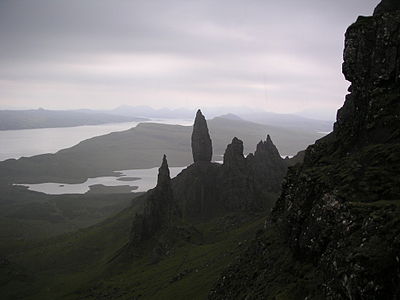
The Storr is a rocky hill on the Trotternish peninsula of the Isle of Skye. The hill presents a steep rocky eastern face overlooking the Sound of Raasay, contrasting with gentler grassy slopes to the west.
The Storr is prime example of the Trotternish landslip, the longest such feature in Great Britain.
The area in front of the cliffs of The Storr is known as The Sanctuary. This has a number of weirdly shaped rock pinnacles, the remains of ancient volcanic plugs. One of the most famous of these is known as The Old Man of Storr.
- February

Dunnottar Castle (from Scottish Gaelic Dùn Fhoithear, "fort on the shelving slope" is a ruined medieval fortress located upon a rocky headland on the north-east coast of Scotland, about two miles (3 km) south of Stonehaven. The surviving buildings are largely of the 15th–16th centuries, but the site is believed to have been an early fortress of the Dark Ages. Dunnottar played a strategic role in the history of Scotland from the Middle Ages through to the Enlightenment, because of the location: it overlooked the shipping lanes to northern Scotland; and is situated on a narrow coastal terrace that controlled land access to the coastal south via Portlethen Moss to Aberdeen during the medieval period.
- March
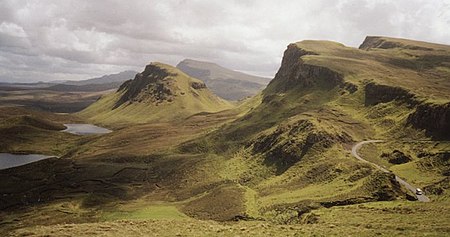
The Isle of Skye, commonly known as Skye, is the largest and most northerly island in the Inner Hebrides of Scotland. In Scottish Gaelic it is commonly referred to as An t-Eilean Sgiathanach ("The Winged Isle").
- April
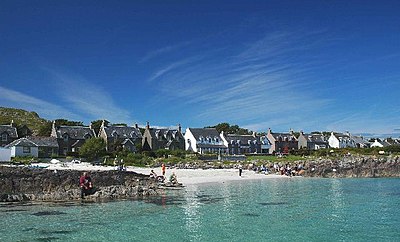
Iona (Scottish Gaelic: Ì Chaluim Chille) is a small island in the Inner Hebrides off the western coast of Scotland. It was a centre of Celtic Christianity for four centuries and is today renowned for its tranquility and natural beauty. It is a popular tourist destination. The Hebrides have been occupied by the speakers of at least four languages since the Iron Age, and as a result many of the names of these islands have more than one possible meaning. Nonetheless few, if any, can have accumulated so many different names over the centuries as the island now known in English as "Iona". Its modern Gaelic name means "Iona of (Saint) Columba" (formerly anglicised "Icolmkill").
- May
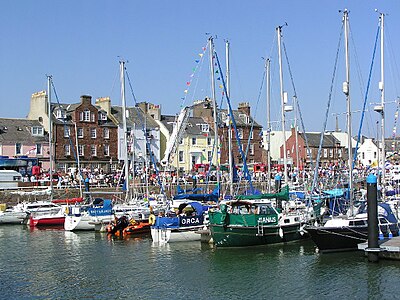
Arbroath or Aberbrothock (Scottish Gaelic: Obair Bhrothaig) is a former royal burgh and the largest town in the council area of Angus in Scotland, and has a population of 22,785. It lies on the North Sea coast, around 16 miles (25.7 km) ENE of Dundee and 45 miles (72.4 km) SSW of Aberdeen.
As a settlement, Arbroath dates back to Pictish times and it remained a small village until the founding of Arbroath Abbey in 1178. Arbroath grew considerably during the Industrial Revolution due to the expansion of the jute industry. A new harbour was built in 1839 and by the 1900s, Arbroath had become one of the larger fishing ports in Scotland.
- June

The National Wallace Monument is a tower standing on the summit of Abbey Craig, a hilltop near Stirling in Scotland. It commemorates Sir William Wallace, the 13th century Scottish hero.
Completed in 1869 to the designs of architect John Thomas Rochead, the monument is a 67 metre (220 ft.) sandstone tower, built in the Victorian Gothic style. It stands on the Abbey Craig, a volcanic crag above Cambuskenneth Abbey, from which Wallace was said to have watched the gathering of the army of English king Edward I, just before the Battle of Stirling Bridge.
- July

Blair Castle stands in its grounds near the village of Blair Atholl in Perthshire in Scotland. It is the home of the Clan Murray family, who hold the title of Duke of Atholl. The Castle is said to have been started in 1269 by John I Comyn, Lord of Badenoch, a northern neighbour of the Earl of Atholl, who started building on the Earl's land while he was away on crusade. Upon his return, the Earl complained about the interloper to King Alexander III, won back his land and incorporated the tower that had been built into his own Castle.
- August

Calton Hill is a hill in central Edinburgh, Scotland, just to the east of the New Town. Views of, and from, the hill are often used in photographs and paintings of the city.
Calton Hill is the headquarters of the Scottish Government, which is based at St Andrew's House, on the steep southern slope of the hill; with the Scottish Parliament Building, and other key buildings, for example Holyrood Palace, lying near the foot of the hill. The hill also includes several iconic monuments and buildings: the National Monument, Nelson's Monument, the Dugald Stewart Monument, the New Parliament House (the Royal High School), the Robert Burns Monument, the Political Martyrs' Monument and the City Observatory.
- September

Crail is a former royal burgh in the East Neuk of Fife, Scotland. Built around a harbour, it has a particular wealth of vernacular buildings from the 17th to early 19th centuries, many restored by the National Trust for Scotland, and is a favourite subject for artists.
Crail probably dates from at least as far back as the Pictish period, as the place-name includes the Pictish/Brythonic element caer, 'fort', and there is a Dark Age cross-slab preserved in the parish kirk, itself dedicated to the early holy man St. Maelrubha.
- October

The Forth Bridge is a cantilever railway bridge over the Firth of Forth in the east of Scotland, to the east of the Forth Road Bridge, and 14 kilometres (9 mi) west of central Edinburgh. It was opened on 4 March 1890, and spans a total length of 2,528.7 metres (8,296 ft). It is often called the Forth Rail Bridge or Forth Railway Bridge to distinguish it from the Forth Road Bridge.
- November

Oban (An t-Òban in Scottish Gaelic meaning The Little Bay) is a resort town within the Argyll and Bute council area of Scotland. It has a total resident population of 8,120. Despite its small size, it is the largest town between Helensburgh and Fort William and during the tourist season the town can be crowded by up to 25,000 people. Oban occupies a beautiful setting in the Firth of Lorn. Oban Bay is a near perfect horseshoe bay, protected by the island of Kerrera, and beyond Kerrera is Mull. To the north is the long low island of Lismore, and the mountains of Morvern and Ardgour.
- December
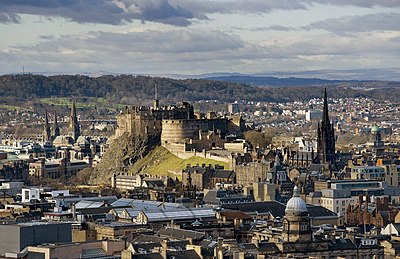
Edinburgh Castle is a fortress which dominates the skyline of the city of Edinburgh, Scotland, from its position atop the volcanic Castle Rock. Human habitation of the site is dated back as far as the 9th century BC, although the nature of early settlement is unclear. There has been a royal castle here since at least the reign of David I in the 12th century, and the site continued to be a royal residence until the Union of the Crowns in 1603. From the 15th century the castle's residential role declined, and by the 17th century its principal role was as a military base with a large garrison. Its importance as a historic monument was recognised from the 19th century, and various restoration programmes have been carried out since.

